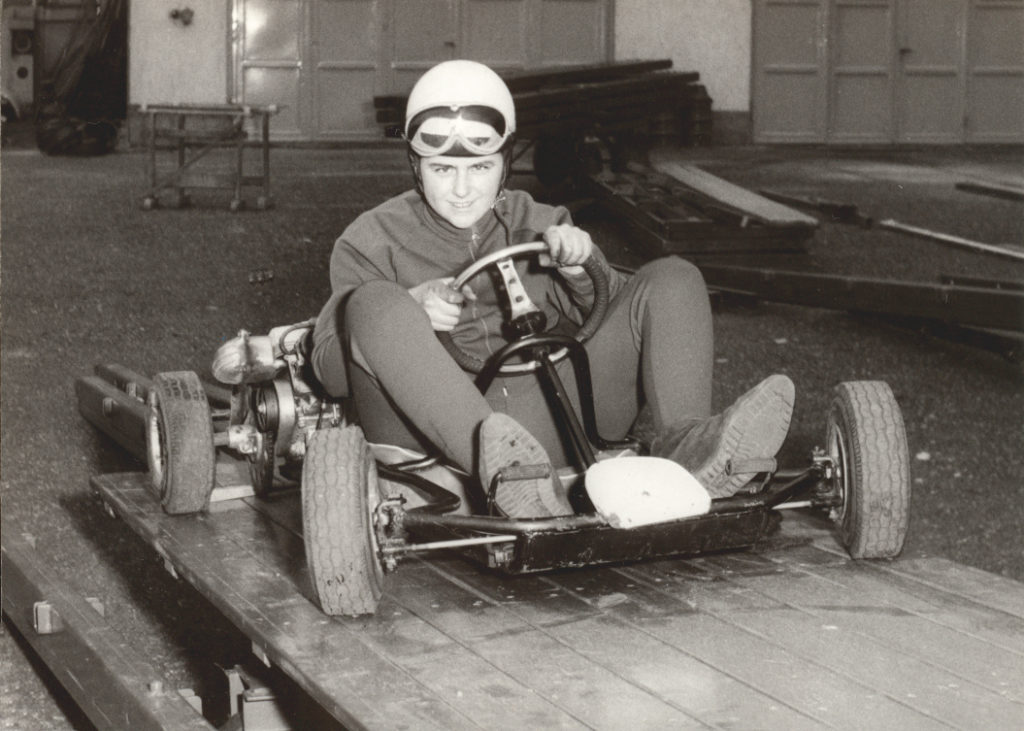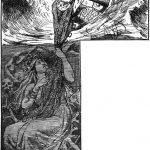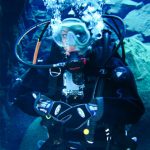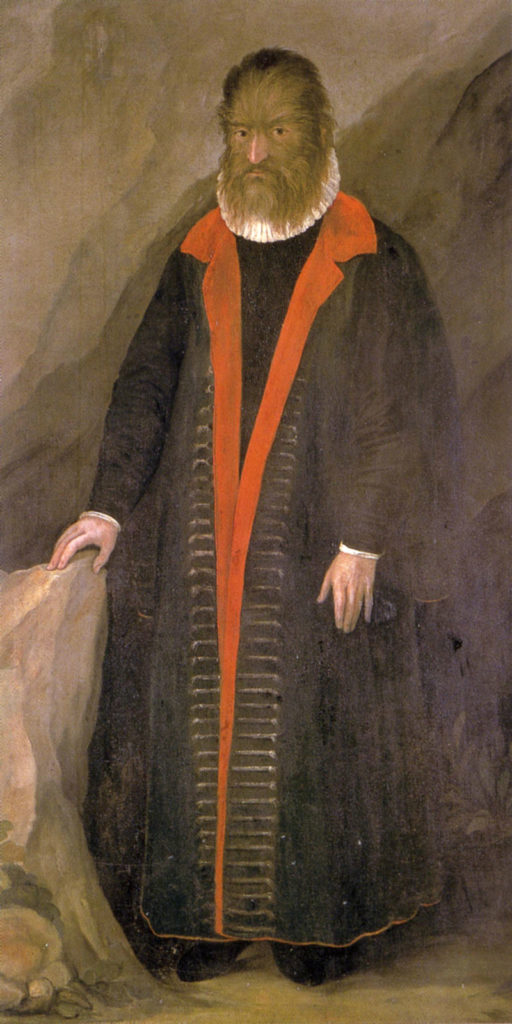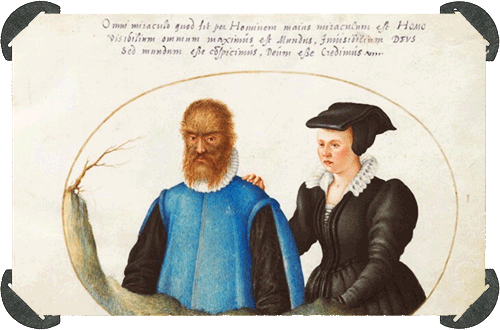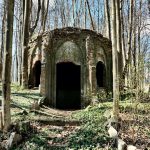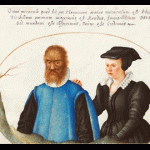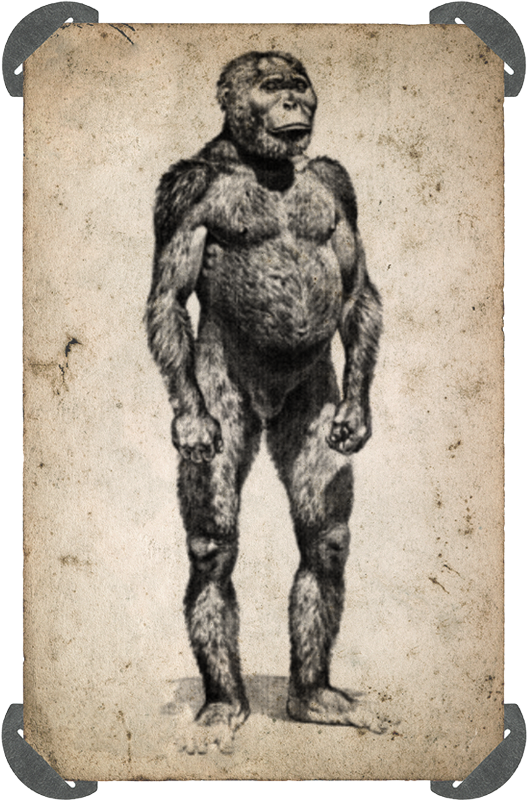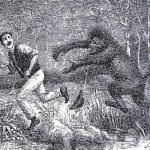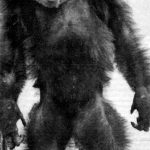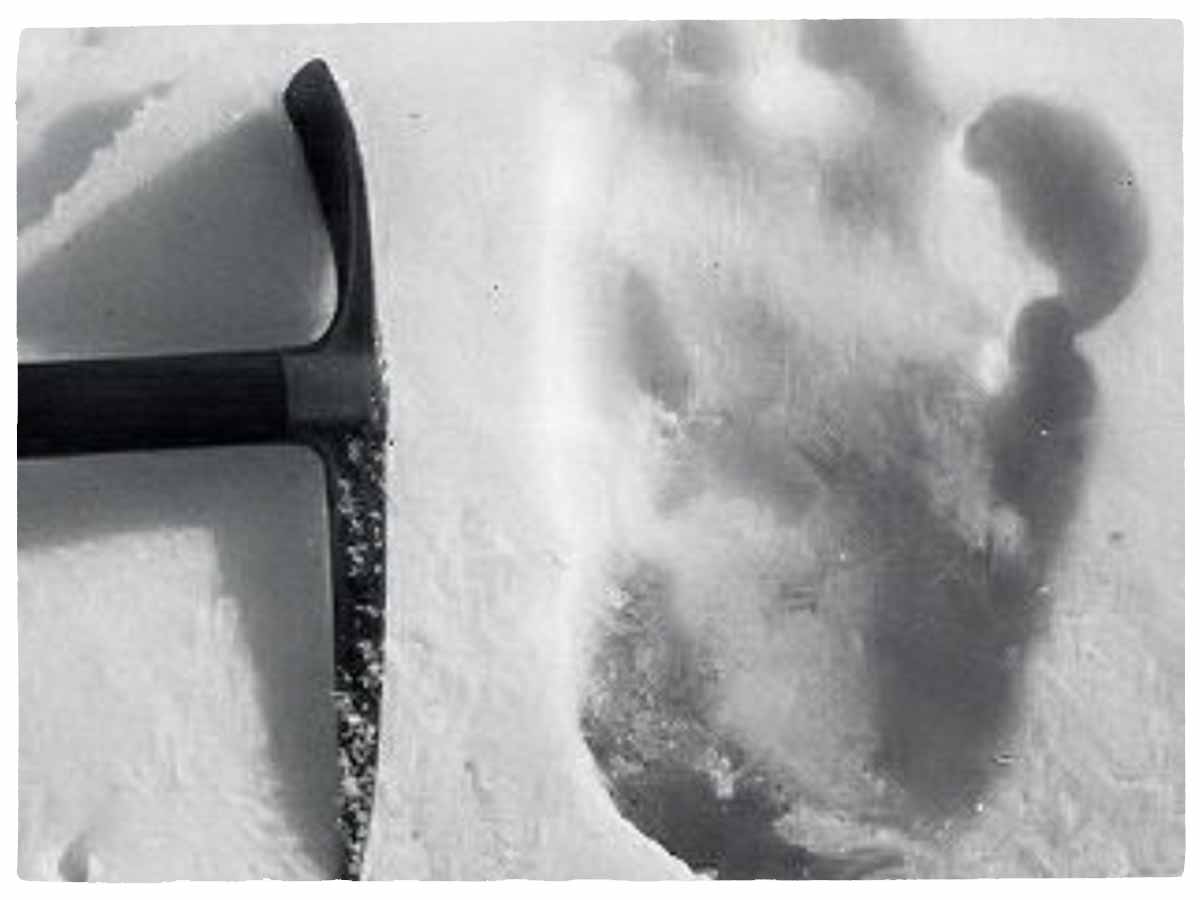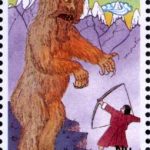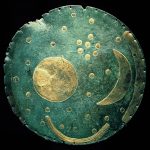Not all that is gold …

North America, second half of the 19th century. The irresistible scent of endless opportunity, freedom, adventure and undiscovered riches fills the continent.
Like so many others at the time, young Theodor Mackaroy had answered the powerful call of gold. After a long and arduous journey across the vast, barren wastes, marked by hardship and exhaustion, he had finally reached his destination. In a remote, unpopulated area (the exact location is not recorded), many other gold-seeking individuals had already set up camp.
Among them were many desperate, poor people who had nothing to lose and everything to gain; a few greedy rich men who had brought their emaciated workers with them and were now forcing them to workday and night to increase their own wealth; a few curious onlookers and even fewer children and women. Only Theodor had other motives.
As the days passed on the supposedly auspicious mountain, which was said to hold almost endless reserves of gold, the frustration and desperation of the gold seekers grew as their supplies dwindled. Only the tiniest, individual traces of gold, little more than delicate dust, could be unearthed.
The masses eventually packed up their tents and followed the alluring, tempting call of deceptive gold further west, hoping to find a great vein of gold in the next mountain range, the next river, the next day, or the day after that, and finally strike it rich.
But Theodor had recognised the real treasure of the area: The fertile soil, which grew barley, millet and wheat, among other things. Realising that this was a central location, he built an inn that soon became a popular and busy stop for prospectors and travellers alike.
The Adventure Club of Europe has records of how Theodor expanded his business and soon had many loyal workers in the fields and at the inn, allowing him to concentrate on his second great passion: Alchemy. Why bother looking for gold when you could make it yourself? But gold was not his only goal; he also experimented with recipes, tinctures and remedies with great success. Sadly, many of his exciting achievements have been forgotten and lost over time.
However, it is said that his distant descendant, a resourceful man named Thomas, who had great culinary expertise and an extraordinary talent for reinventing sumptuous delights, rediscovered one of the original recipes that was thought to be lost. He is also said to have refined and modified the original recipe to produce a concoction, known as ‘liquid gold’, that is as beneficial as it is delicious. It is said that prosperity and good fortune will always follow those who wet their throats with the legendary liquid gold.
ACE is currently investigating these modern legends and will report here as soon as new findings are available.
Property of the club:
Contemporary witness footage and current eyewitness accounts. ACE is unable to provide further details at this time as this is an ongoing expedition.
The Bacchus vine from Castle Ollwiller

In 1849, 25-year-old Georges Louis Grandidier graduated with a doctorate in Botany and Agricultural Science from the University of Strasbourg. Due to a lack of significant connections, however, his only option at the time was to take a less-than-prestigious teaching position at the newly founded Haut-Rhin agricultural school at the Castle Ollwiller winery.
Bored by the lack of challenging teaching, the passionate teacher soon found distraction in the archives of the castle; and with Claire, the charming daughter of the castle owner…
However, one day Claire fell gravely ill, and no doctor knew how to help her. As her condition rapidly deteriorated, George’s despair grew. He feverishly sought for a way to heal her. Finally, he even put aside his rigorous scientific skepticism: in the archive of the castle, he had repeatedly come across reports from across the centuries that spoke of a mysterious, wondrous wine that had been made by Ollwiller from time to time. It could give life, however at the same time could bring death.
He had previously thought this to be a curious legend, but now in his despair, he would try anything, leaving no stone unturned. Using old plans from the archive, he delved deep into the vault below the castle.
There he came across something unreal: in front of him lay the ruins of an ancient temple. At its centre, a vine had miraculously flourished. Despite the fact that no sunbeam could ever reach here, fresh green leaves had grown on the vine and it was covered with lavish grapes. Georges had an enormous realisation: had he truly found the Bacchus vine?
“The professional world has always dismissed it as a legend. Nevertheless, everyone at the Faculty of Agricultural Sciences had heard the story of the divine grapevine that was said to have been by the Romans to what is now Alsace, 2000 years ago”,
wrote Georges, many years later, in a letter to the Adventure Club of Europe.
“In order ensure that wine grapes would be able to flourish here, they built a temple to Bacchus, their god of wine, vitality, the arts, ecstasy, but also madness. There they planted a vine that had come from the Shrine to the God in Rome itself. When a priest drank the correct amount of this wine, Bacchus would give him vitality, inspiration and creative energy. However, if one failed to imbibe the correct dose and drank too much, they would go mad.“
Georges decided that the castle must have been built on the ruins of this temple. The divine vine of Bacchus had survived through the centuries and must have been used occasionally, hence the reports of a wine that bestowed great vitality on its drinker, but could also lead to fatal madness.
Georges made wine from the grapes, the best he had ever tasted. Before giving Claire a dose, however, he diluted it with water and ice: this allowed her to recover without dying from madness.They married, and Georges finally became the director of the School of Agriculture. So it fell on him to protect the Bacchus vine throughout his life. He never made the discovery public, as it seemed too dangerous.
As he came to the end of an unusually long life – the vine only provided vitality, not immortality – he began to worry about how the vine could be properly protected after his death. Through scholarly circles, he came into contact with members of the ACE, and wrote to the president at the time detailing his discovery and asking the ACE to watch over the vine from now on.
Incidentally, it is said at the ACE that Dr. Georges Louis Grandidier not only protected the divine grapevine, but had also experimented with it. He is said to have crossbred with other grape varieties, in order to retain the wines healing properties, but also remove its dangerous effects. In fact, it is still said today that the those enjoying the ‘Grand Cru Ollwiller’ feel particularly invigorated and inspired…
The Unexpected Balloon Ride to Liechtenstein

An exciting discovery has recently been made by students from the European Adventure Academy in the old archives of the ACE. The find in particular is the research diary of a previously unknown balloon expedition carried out by aviation pioneers Eckbert and Kaspar Eulenstein from 1823. According to their notes, the brothers were planning a hot-air balloon expedition to England to carry out flight experiments, to observe the updrafts and downdrafts over land and sea, and to study the flight behaviour of birds from up close. The winds were favourable when the two climbed into the hot-air balloon on the forecourt of the Voletarium, their workshop at the foot of the Black Forest. But it was then that something completely unexpected happened, as noted by Eckbert:
“We had just reached a good altitude, and by all logic and by all precise calculations, we should have been moving north-west, when all of a sudden, we were caught in a strong current of air that blew us in the complete opposite direction! We couldn’t explain it.”
The brothers could only watch in amazement and take eager notes as they were carried in a straight flight over Switzerland. Kaspar wrote:
“We’ve been traveling at a fairly constant, brisk pace for almost two hours now. The wind that carries us seems to act only on the balloon; the birds around us don’t seem to be affected by the current at all, it’s very strange!”
When the air current finally died down, the brothers found themselves over the Alps. Soon, the Eulensteins spotted a conspicuous, meter-high cone of green light radiating up from one of the mountaintops, visible far in the distance. Kaspar’s description of the exciting events that followed was recorded in very hasty handwriting:
“The wind that has brought us here is starting to ease, and we are sinking significantly! A decidedly unfavourable place, in the middle of high mountain ridges, and we are moving right towards this mysterious green light! Every attempt to gain control has so far failed. We cannot steer, we can only hope and wait…”
Fortunately, their concern soon turned out to be unneeded, as the following entries from the brothers describe the balloon landing almost on its own and safely on a high mountain peak. Modern reconstructions of the route tell us that this was the highest mountain in Liechtenstein, the Grauspitz, which at that time could not be climbed due to its steep and impassable mountain slopes.
Eckbert wrote:
“We touched down on the ridge of the mountain not far from the bright green light phenomenon. Its radiance is even more intense here and certainly has an unusual appeal. After a brief consultation, we decided to take a careful look at the remarkable phenomenon up close.”
Unfortunately, the record of the light phenomenon ends here. The next documents available to the Club only describe the return journey by hot air balloon. It very much appears that the Eulensteins concealed what they found on that mountain in their private research records, as well as what knowledge they gained there in Liechtenstein. What is certain, however, is that this expedition reaffirmed their belief that they needed to develop a steerable aircraft, to ensure they never became passengers of the winds again. These essential insights enabled them to successfully implement their plan only two years later.
The ACE is now planning a series of balloon expeditions in Liechtenstein in the near future to research the extraordinary events and reconstruct the Eulensteins’ excursion, and ultimately track down the mysterious phenomena.
The Ghost Car of Waldkirch
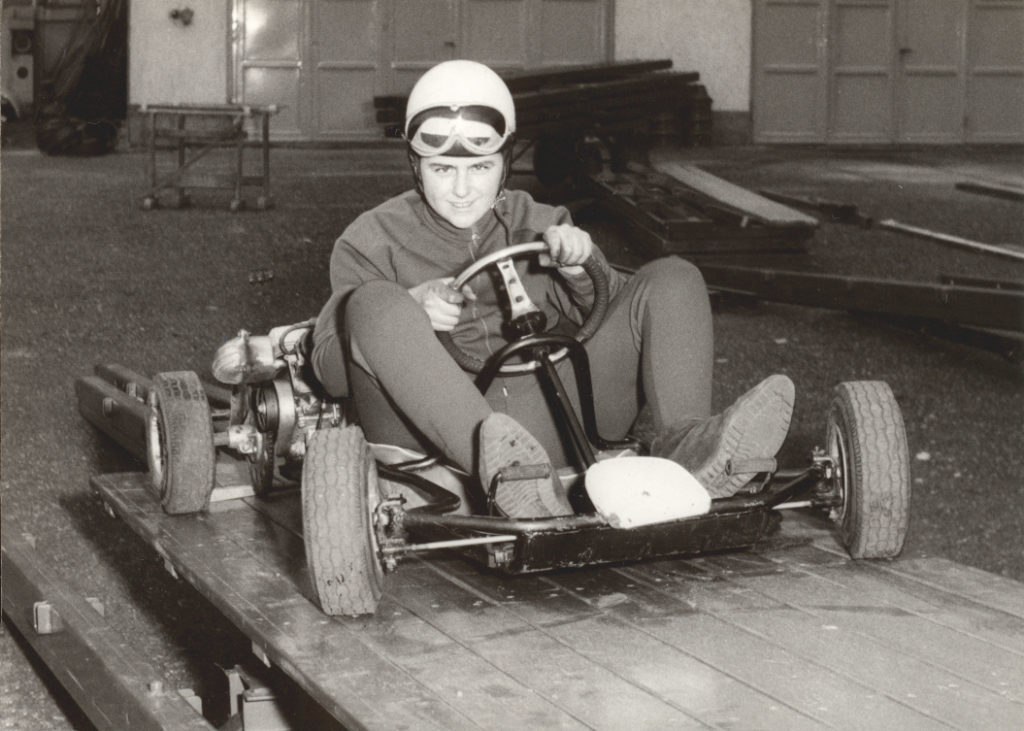
Broken glass of the shattered shop window sparkles in the moonlight. Family Börschig comes running out of their butcher’s shop onto the street and they are furious.
‘It has struck again’, whispers a neighbour who stretches her head out of the window. ‘It’s back.’
In the distance an engine howls, the children hide behind their father.
Then it gets quiet.
It was called many different names since the end of the 1950s as it was causing trouble in Waldkirch and the surrounding areas. It was called ‘the bowl from hell’, ‘devil box’ or ‘ghost car’. But what lies behind these legendary names? In order to understand what one of the greatest myths of recent Black Forest history is all about, we need to travel back in time.
It all began on a sunny day in the autumn of 1957. More specifically, on the 12th of October. On his eighth birthday, today’s ACE honorary member Roland Mack received a very special gift: a discarded, small petrol driven car that came from one of the first ‘bumper cars’ built by Mack at the time and which are now known the predecessor of the popular go-carts. For weeks, his father Franz Mack had revamped the discarded vehicle. He even had a more powerful engine built in to give his race-loving son a special treat.
The gift achieved its effect: Young Roland and his car were inseparable. Every day he went as far as the fuel allowed and he developed a big dream: he wanted to become a racing driver.
So far so go. But about what happened next, opinions beg to differ. Different stories were spread by residents of Waldkirch over the decades which led legendary researcher Fritz Erchinger to reconstruct the most probable course of events on behalf of the Adventure Club of Europe in an elaborate piece of work:
One night, the Mack family was sleeping soundly, young Roland was woken up by a motor noise. Unusual for the area in the late 50s. He went to the window and looked wide-eyed as his petrol driven car shot out of the garden shed and disappeared into the darkness.
Believing in a theft, Roland searched the area with a flashlight, but was unable to find his car. Disappointed and exhausted, he went back to bed, only to find the car in the garden shed the next morning. What happened? Did someone secretly kidnap the car? Or maybe he had just dreamed everything?
Over the following weeks horror stories spread about an alleged car, which was causing trouble in and around Waldkirch at night time. The most widely used term ‘ghost car’ was attributed above all to reports of eyewitnesses, who firmly stated that the car had driven through the streets without a driver.
‘My grandma said it was like a werewolf‘, wrote local author Willi Thoma once explaining the phenomenon. ‘It only came out in moonlight. It had its own will. Once when I was unable to sleep saw it in front of our house. And I swear, it drove on its own.’
Others blamed the witch Gfällrote for the mischief says the legend researcher Erichinger. Gfällrote was causing trouble around the Kandel area according to another Black Forest legend. ‘The car was spelled by the Gfällrote, my uncle used to say’, said former shoemaker Hans Streich, according to research in a radio report in the 90s once with a laugh.
Roland Mack himself is not commenting on the legend of his former vehicle.
‘I can’t remember what happened exactly’, he said with a wink when asked about the legend at an event of the Adventure Club of Europe in the summer of 2017.
But in an interview with Mr. Mack from the 70’s which he had given shortly after the opening of Europa-Park, Erchinger finally found some interesting insights. In it, the 30-year-old Roland described how he finally found out about the secret of the ghost car.
After watching his car vanishing night after night without a driver young Roland encountered similar experiences in an old family biography that Paul Mack had reported around the year 1800. The founder of the company, which is now called ‘Mack Rides’, observed at that time how a mechanical carousel he built in his spare time turned at night by itself.
After a long research Roland Mack finally found out that his father Franz had used old components of the family company for the restoration of the gasoline car. Underneath a coil, which according to legend should come from the first carousel of the family.
Roland Mack began fiddling with the car, which, as he described later, first sparked his interest in engineering. But before he managed to find the coil, it got dark. With young Roland in the driver’s seat, the car came to life as if by magic and raced through Waldkirch. It headed for the bakery window and an impact seemed inevitable. But at the last moment, the 8-year-old Roland managed to tame the car. He removed the coil and regained control of the car.
From one day to the other ended so the ghost of the ghost car of Waldkirch, which is still unforgotten today.
After the Mack family moved, the car stayed n the old factory below the Kastelburg for a while. Over the decades, it was forgotten until it finally disappeared from the scene. But Roland Mack had much to thank his vehicle for. His interest in mechanical engineering was symbolically linked to his passion for fast-paced rides, which ultimately resulted in the construction of countless thrilling roller coasters.
It was not until 2019 that another surprising change in the history of the Ghost Car of Waldkirch came about. It was rediscovered by Roland’s eldest son Michael Mack at the Musée des Arts Forains.

On the occasion of his 70th birthday, the reunification between Roland Mack and the legendary vehicle from his childhood finally took place.
Today, the Adventure Club of Europe is proud to announce that Roland Mack has provided ACE with the historic petrol driven car as an exhibit.
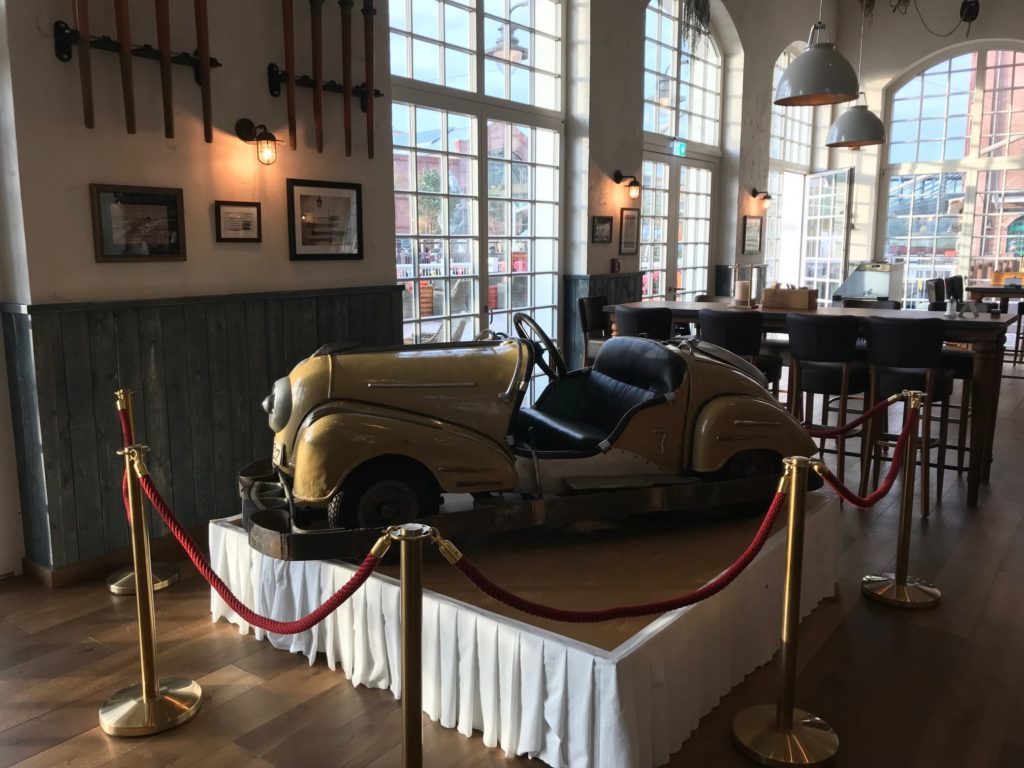
And when asked if he still had the old coil of Paul Mack, Roland replied with a wink when handing over the car:
‘Let’s wait and see what happens after nightfall, maybe we can here an unusual engine howl in Rust when the moon is out – then we know the spook continues.’
The Troll from Grønligrotta
It was a mild summer evening in the tranquil town of Mo i Rana, Norway, when the two friends Kjell and Morten rode their bikes through the gaping, empty streets. ‘Mild’ – not far south of the Arctic Circle, that of course meant no more than 13 or 14 degrees, but was just enough for the two young people to enjoy the summer in T-shirts. The weather was not the problem either. It was boredom. They knew every street, every stone, every shop, every club. There was nothing new to discover.
They still had two years to graduate in 1986 – two more years until they finally got away. Where did not matter. Just wherever there was more to experience than here.

The fact that many years later, Kjell Henriksen and Morten Holm would make history as known speleologists and members of the ACE, would hardly have been expected of the two skinny boys at the beginning of the 1980s. But even then the spirit of discovery burned in both of them.
When they saw the signpost for the well-known cave Grønligrotta on the outskirts, they suddenly got an idea. Although their parents had forbidden them to go into the cave alone, secretly they had always been fascinated by the four-kilometre-long limestone cave, in proximity of their hometowns and with many myths and legends associated with it. And as every adventurer knows, boredom and curiosity can create an explosive mix.
The two decided to secretly leave home at night and finally explore the legendary cave on their own with provisions, sleeping bags and flashlights..
It was almost like a cathedral. As a 16-year-old I had never seen something so beautiful. And what really opened my eyes in that moment was the realisation that it had been hidden here all my life. Half-hidden under the boring streets of my hometown. I wondered what underground secrets this world still has to offer. Untouched places just waiting to be seen by the human eye.
– Kjell Henriksen
Euphorically, the youngsters penetrated ever deeper into the cave until they reached an underground river. In their carelessness, the two decided to cross him without security. And as was bound to happen eventually, one of the unstable limestone slabs dissolved under their feet and they were tugged downward by the river into a pit hundreds of meters in depth. When they came to, it was pitch black. They had lost their backpacks and flashlights on the life-threatening slide. But all in all: they were alive. Panicked, they felt their way through the dark caves, but it was impossible to orient themselves. Slowly it dawned on them what that meant: they were doomed.
Just when I was about to burst into tears, I saw a spark of light in the distance. I’m hallucinating, I thought. But it was getting bigger. Kjell also finally caught it. We called for help, but nobody called back. The closer the light came, the more our fear grew. And then we saw him: Södtjofsvörnson.
– Morten Holm
The glow of his staff illuminated his wrinkled face. He was perhaps a metre tall and looked at the boys urgently.
He told us that we had delved too deeply into his sanctuaries and that he would have instantly hexed us if he had not seen the righteous fear in our faces. If we did not want to stay down here, like him, forever, then it would be a good idea to leave quickly. We begged him to do nothing to us and just show us the way out. He raised his staff and a bright light blinded us. Then everything went black.
– Kjell Henriksen
When the youngsters came to, they found themselves at the surface again. In a mixture of shock and enthusiasm they ran home. In the weeks that followed, they devoured all the stories and legends about the cave and kept coming across tales of an old troll living in Grønligrotta. Other medieval sources reported Södtjofsvörnson, an old man who, according to a legend, had retreated to the cave hundreds of years ago to experiment with magical crystals. That’s what he had to be – Kjell and Morten were sure. Of course, their parents, teachers and friends considered it nonsense, but the two knew better: After all, they had seen him. And he had saved their lives. Their passion for the supernatural and speleology was born. And today, more than 30 years later, Kjell and Morten have a remarkable track record: most of the cave systems discovered in recent decades north of the Arctic Circle were found and mapped by the two.
And even when, years later, they returned to Grønligrotta as professional researchers, they never found Södtjofsvörnson again.
It is said that he helps only those who naively and thoughtlessly go into danger – and we are now far too professional. Although … perhaps Kjell more than me (laughs).
– Morten Holm
The Sun of the Night Ocean
2009

When the Icelandic archaeologist and scuba diver Sonja Gudridsdottir freed the mysterious statute from the seaweed and reappeared at the surface of the water, her heart throbbed. There was no doubt in her mind, the wreck that rotted deep below her at the bottom of the sea was the ship on which her esteemed professor and doctorate supervisor Hans Hoas had last been seen! At the same time, she realised this also meant that his expedition to the Nordic Sea had failed – which explained why no one has heard from him in such a long time. Only his corpse was not on board. Maybe it had floated somewhere in the shallows. Sonja shivered. She knew the statute from the recordings of the professor too well. It was the statute of the sea goddess Ran which should have been on the Tre Kronor, a royal vessel which once set out to find the fountain of life.
![]() Old records stated that the statute served as a lucky charm to appease the sea goddess during passages. Due to a scatty adjutant, an overworked captain or simply because of thoughtlessness, the statute had been forgotten at the harbour during an expedition many centuries ago. The ship sank and was never seen again. The absence of the statute was blamed for this, people believed that protection from the sea goddess wasn’t provided any longer. What made matters even more mysterious for Sonja was that the professor’s ship sank even though he had the statute on board! Clutching the statue, Sonja recalled what she had read in old writings about Ran:
Old records stated that the statute served as a lucky charm to appease the sea goddess during passages. Due to a scatty adjutant, an overworked captain or simply because of thoughtlessness, the statute had been forgotten at the harbour during an expedition many centuries ago. The ship sank and was never seen again. The absence of the statute was blamed for this, people believed that protection from the sea goddess wasn’t provided any longer. What made matters even more mysterious for Sonja was that the professor’s ship sank even though he had the statute on board! Clutching the statue, Sonja recalled what she had read in old writings about Ran:
”…During the day, the giant Dag rode across the sky and made the water of the oceans sparkle in the reflection of his horse, Skinfaxi, whose glowing crest illuminated the world with its shine. At night blackness ruled in the shallows of the sea and many sailors lost their lives.
The sea goddess Ran ruled the oceans with her husband, Aegir, and took the drowned people to her kingdom of the dead. She constantly considered how she could capture the brightness of the sun so that her oceans would also glow at night. The human’s gold captivated Ran and it seemed to her right on cue for this purpose.
So it happened that Ran promised lost explorers their lives when they gave all their treasures to the ocean in return.
Ran hoarded all her treasures at the bottom of the sea and the luminescence which was generated by Ran’s gold lit up the night. The glistening white crests that carried her nine wave daughters and the glistening bright nocturnal spray was soon known as “Meresvlam”. Some also called it “Ran’s sun” or “sun of the night ocean”.
On the morning of the 10th August 2009, Sonja started out with her motorboat. She had found a few possessions, money and a gold watch, together with recordings of the professor in a waterproof cash box which she stowed away on deck together with the statute in a box.
Sonja took the course the professor had mentioned in his notes. It was a calm ride, illuminated by the sun, and she was in high spirits. But when night approached and the first polar lights began to dance on the water, a storm Sonja had never experienced before appeared. Her ship was tossed back and forth on the waves, masses of water gushed on deck.
”I tried to hold on to the ship’s rope with all my strength when the boat was dragged down. It was like an undertow of unimaginable power, almost as if the water was brought to life. In the next moment, the ship touched down rough. The box with the statute hurled through the water and slammed against the railing. It opened with the impact of the collision and the statute fell out. In the next moment, a gigantic, almost transparent figure rose from the bottom of the sea and glared at me provokingly. Only then did I see that everything was illuminated. The entire seabed was covered with gold and was shining like the glistening sun. And then I saw him! Professor Hoas floated in the water attached to an anchor chain with cold, dead eyes. Behind him there were other people with drowned eyes like him moving animatedly – some drank mead, others were even dancing! Then the scales fell from my eyes! It meant that Ran gave lost sailors their lives if they gave their treasures to her in return. But it doesn’t automatically mean that they could not drown. If they had paid their tribute, then Ran granted them a life in her kingdom of death, amid her treasures!
I instantly tore the chain off my neck, pulled my rings off my fingers and gave them to Ran. Ran looked at me, scrutinizing. In panic, I remembered the possessions from Professor Hoas, took out the cash box from the case and threw her the money and the watch. The air in my lungs began to grow scarce! Ran sighed slowly and a smile spread over her face.
From the corners of my eyes I could suddenly see a bright shinning light which wasn’t there before. I turned around and saw that the statute had started to glow. Hastily I swam to it and clutched it. Just as quick as I was dragged under water, I was catapulted to the surface of the water. From the corners of my eyes I could barely see how the anchor chain came loose of professor Hoas’ ankle and it seemed to me that he was waving goodbye.”
![]() As we know nowadays, thanks to Sonja’s life-threatening commitment, the statute had also saved Professor Hoas. But avarice eventually became his downfall. It wasn’t the despicable Mammon who was found with the help of the statue but insights that are of vital importance – because only those who are willing to give something of themselves receive glory and wisdom.
As we know nowadays, thanks to Sonja’s life-threatening commitment, the statute had also saved Professor Hoas. But avarice eventually became his downfall. It wasn’t the despicable Mammon who was found with the help of the statue but insights that are of vital importance – because only those who are willing to give something of themselves receive glory and wisdom.
The beast of Tenerife
![]()
During an extensive journey as part of her photographic studies, a then only 27-year-old Carolina Francisca Zavala succeeded in tracing the long lost remains of the legendary Beast of Tenerife. In her expedition report she writes:
Even as a child, only six years old, I was fascinated by Jean Cocteau’s film La Belle et la Bête (Beauty and the Beast). I watched it countless times with my grandfather in his cinema in Bilbao. Later, when I watched the cartoon, Beauty and the Beast, for the first time the story overwhelmed me again and still fascinates me to this day.”
During a trip to the Canary Islands Zavala heard out about a Spanish nobleman, Pedro González, who was in his time time (1537) known as the Beast of Tenerife.
When I heard the story of Pedro González I immediately had the vague feeling of having heard of him before. After some exhaustive research I indeed came across a story by the French writer Gabrielle-Suzanne Barbot de Villeneuve, who is considered to the author of the first literary version of Beauty and the Beast. Apparently, she had already stumbled upon the legend of Pedro González in 1740 and had been considerably inspired by his life. Little by little I realised that the ‘beast’ in the stories must have been him. In my inquiries I learned that Pedro González was taken to the court of King Henry II at the age of ten for his amusement, as he was considered as a monkey.
Due to his illness, a form hypertrichosis characterized by unusually strong hair growth, he was often ridiculed as being a ‘monkey’ or ‘wolf man’. In his youth, González fell in love with a young woman and tried to win her heart. She, however, scorned and mocked him. The public humiliation reached its sad climax when she invited him to her wedding with a handsome prince – to amuse the wedding guests.
I was boiling with rage when I heard that! Pedro González, who was now under the protection of Henry II and even spoke Latin, was a nobleman. He did not want to accept this disparagement and swore revenge. However, in the two-man fight with the prince, it was evident that he could handle only the feather, not the sword. Being heavily injured, his only option was to escape.”
Inspired by this discovery, Carolina later decided to pursue the story of the Beast of Tenerife. She traveled to Italy – with the help of her Barcelona Academy of Art scholarship – to take pictures of the landscape. Here she was able to prove that González had indeed survived the sword fight.
At the court of Margaret of Parma, paintings from around this time emerged showing González in an array of noble costumes. He had indeed found a woman who recognized his good nature and married him despite his appearance! No anomaly is documented in the paintings. Her skin is delicate and soft and completely without beard. My heart hopped as the mosaic stones joined together more and more. The fairy tale, which as a child I loved so much, was actually based on a real life event. Pedro and his wife Catherine had even seven children together! I wanted to know all about him, not only where he had lived, but also where he had died.”
She spent several days in Parma talking to librarians and noblemen. Again and again she visited cemeteries and ruins dating back to the time and wandered around the former lands of Margaret of Parma. Sadly here the trail was lost. Her initial euphoria turned into consternation.
For days I had been running around tirelessly and my feet were aching as if I had walked for several centuries. I had wrestled innumerable books and folios with old trunk trees, rattled cemeteries, and found no new clues.”
Although she had already planned her return journey, she once again went out to the country to shoot a few last photo memories.
As I looked through the view-finder of my camera I could hardly believe my eyes. In the middle of the forest between all the trees, the weathered outline of a stone crypt was revealed. As I approached I discovered that the crypt was empty. I was just about to leave when I saw the contours of a coat of arms exposed by wind and rain on a broken stone slab of an adjacent mound: the coat of arms of Pedro González! With all my strength I pushed the table aside and opened the secret entrance. Excitedly I turned on my flashlight and descended into the hiding place. In front of me a crypt revealed itself in the midst a nearly unharmed sarcophagus. A large, mossy stone tome was pinned to the wall. Trembling with tension, I scratched the moss and saw the words that had lasted for centuries:
‘Beloved father and faithful husband, Pedro González. In eternal gratitude, Catherine, Tognina, Alejandro, Anna, Francesco, Leonardo, Tia and Maria.’
I had tears in my eyes as I saw this love story finished right in front of me. It was by far one of the most striking moments of my entire life!”
When the sarcophagus was later opened under the supervision of some archaeologists from the Adventure Club of Europe (ACE), a well preserved death mask and remains of noble, courtly robes were found near Pedro Gonzalez’ bones.
The death mask has been in the possession of ACE since then. Carolina Francisca Zavala was solemnly accepted as a new member for her important find.
![]()
The giant chimpanzees of Congo
![]()
Expedition report by Lady Victoria Stanley
“The jungle still keeps great secrets from us”, I said, as I took the first step away from the well-trodden paths into the wild jungle. We were in the Congo, in a region around Bili and Bondo, in search of giant apes.
Everything we knew about these animals came from a few legends the inhabitants of this area has passed onto us. What was true and what was myth, I couldn’t judge. I am a woman of science, not of chatter. Besides, I had a transcript from Belgium with me and looked carefully after it, as if it were the Bible. In 1898 a Belgian officer brought three monkey skulls from this area to Brussels. They were extraordinarily large and were regarded as nature’s caprices. I do not care about their whims. I wanted to see these monkeys and would look for them until they presented themselves to me.
We had heard from local hunters of monkey populations in a western forest, through which a stream passed and a smaller population in the east in an area to which even the young men of the region were frightened to go.
One of my five Askaris was a very clever fellow, agile with the gun and keen in his senses. I liked to watch him as he was looking for tracks and heading the expedition through the jungle. He may have saved us more than once. It was this young Askaris who heard drums and shouting on the third day of our expedition, the 20th of October. I had not heard anything, my heavily built colleague, Engeland, and the other Askaris kept their ears wide open but were unsuccessful on account of the wind. I did not care much about their ears. They had been hurt by gunshots and worn out, deaf from the eternal gossip of their wives. My first Askaris, however, moved smoothly through the jungle and I followed him blindly. Soon I also heard a scream and a stomping drumming. All the others had stayed behind. I was not afraid, sensing the close discovery only a few meters in front of me in the growing, narrow jungle. A penetrating scream could be heard through the forest. A great ape. Finally I saw him. At a distance of perhaps 10 meters, sitting right there on a stone. Behind him there were about ten other animals, stamping dangerously on the ground. I could not classify them – I had never seen such a species. Their body size rendered me speechless. Some of them must have measured up to 2 or 3 meters. Their fur white, black and mottled grey. The stones on which they were sitting seemed to be arranged into a formation. Yes, I’m sure they were strong enough to be able to drag the weight of stones of this size. I shuddered when I caught myself thinking of how they must also be unusually intelligent to create such a formation out of them.
Once again the ape cried out and looked directly into my eyes. A hand grabbed me from behind. It was the Askaris, he pulled me away. Perhaps he saved my life from these enormous apes, but at that moment I just hated him. I had no evidence, nothing. I only had a throbbing heart and empty hands.In the days following we did not find the stone formation again.
What were these beings? We had, after all, found ground nests. But chimpanzees prefer to go back to trees to sleep, so we were dealing with a species that builds nests. I was terribly nervous and yet full of a great need to take action. These monkeys belonged to me. And yet … I had the feeling that I was no longer pursuing these giant monkeys – they had taken possession of me and pursued me, every night, deep into my deepest dreams.
I had directed the expedition to a volcano in the west and hoped for the population of the apes to be spotted there. At 3100m we pitched a tent. We had covered the ground softly with moss. The mountain ridge was so narrow that the tent poles had to be put down on a slope.
At night they caught up with us. From our camp we saw a herd of giant black and white apes trying to climb the highest peak of the volcano. While my sweaty colleague Engeland was shooting excitedly into the sky, the Askari shot down two of them with poison-tipped arrows. With a great clambering they fell ungraciously into a crater gorge. The rest of the flock fled as this happened. After five hours of exhausting work we managed to get one of the roped-up dead animals.
It was a male ape of about two and a half meters in size. He weighed over 350 pounds. His white breast, hands, and feet were all of immense size. I was shuddering as this gigantic ape lay so silent, so dead in front of me. This was no chimp. Gorillas were known to me from the lowlands, but not here. Then I felt this growing feeling of happiness brought on by having made a real, new discovery. This was the expedition of my life.
We finished our research and returned promptly. I was inspired and did not yet realize that the locals had panicked so much as they did. They believed that I had killed a ghost and they would be punished for it by illness, natural disasters, and diarrhoea, or whatever. Also, the first Askari, who I thought to be such a bright lad, now turned away from me.
I sent the great ape to London to the British Natural History Museum. It was true that a disgusting hyena unfortunately ate some skin and a hand from my ape, but its countenance was confirmed by its skull and skeleton. I had discovered a hitherto unknown species of chimpanzee.
Even today, I think of my greatest discovery fondly and often, and despite all my pride, I’m struggling with the unresolved question of what the stone formation was all about. I sincerely hope that those who come after me will one day solve this riddle.
In the possession of the Adventure Club of Europe
Artefacts:
- A piece of the mountain gorilla encountered by Lady Stanley
- A drawing from Lady Stanley’s memory of the gorillas in stone formation
- Der tapfere Engelton.
![]()
The Yeti of Bhutan
It was midnight in May 1951, when the internationally known climber and esteemed Adventure Club of Europe member, Richard Steinwinkler, reached a remote high plateau in the Himalayas. His expedition: The ascent of the eight-thousander Kula Kangri without flames oxygen and accompaniment. I was looking for a suitable place to rest, as I suddenly saw in the corner of my eye, a large figure disappearing behind an overhang”, as Steinwinkler describes the moment that stopped him.
![]()
Instinctively I thought immediately: The Yeti. At this time, I had certainly already traveled the High Asiatic area 10 or 15 times and in none of my visits I was able to get any credible evidence for the fact that the snowman actually exists. To be honest, I thought the idea of a Yeti was a made-up fantasy. And yet – in that moment – I knew I would not come to rest here. So, I moved quietly and carefully to the overhang, behind which I had noticed the creature. “
Steinwinkler, who had been nominated the climber of Europe the previous year, describes the moments after he had run around the overhang, as initially sobering.
Far and wide nothing was to see and slowly my pulse went down again. If in front of me a huge footprint in clay would not have appeared, I would have thought everything was just imagination.”
After taking a photograph of the footprint, Steinwinkler followed the footprints of the creature for hours, before he came to a slope and looked up to another plateau.
And then I saw him. About 50 meters away, about four meters tall, he ran around on two legs and it was difficult to identify as long as he was moving. When standing still, his silhouettte was merging with the piled-up stones on his left and right.
My only thought was, I hope he doesn’t notice me. All the curiosity, all the euphoria was suddenly gone. There was only reverent fear. With shaky fingers, I reached for my camera and took several photographs. Then I crept slowly back. This was my first and last encounter with the Yeti.
His discovery brought much ridicule to the recognized mountaineer in the following years, and the authenticity of his photographs was always doubted. Richard Steinwinkler does not understand this to this day.
I know that the Yeti exists. But I am not saying that it is the mythical creature that people have been talking about for thousands of years. Perhaps it is a completely unknown animal species. Something ape-like or bear-like. I consider it naive to think that we humans have already discovered everything that is out there.”
Four years later, on August 8, 1955, another chapter of the Yeti story was written. From a Nepali friend who wants to remain unknown, Richard Steinwinkler received an amazing gift on one of his journeys: the supposed scalp of the Yetis, salvaged from an abandoned monastery in Tibet.
I was skeptical at first, whether I should accept this gift: either the scalp was fake and I published a scam – or the scalp was real and belonged to an animal – maybe the Yeti – that might have been chased and killed. The idea that the Yeti could end up on the shooting list of poachers frightened me. Nevertheless, I decided to take the scalp and make it available to the Adventure Club of Europe.
To this day, the supposed scalp of the Yetis can be admired in the ACE’s clubhouse. In 1999 a DNA analysis of the hair resulted in the fact that the scalp cannot be assigned to any known animal species.
![]()
The Sky Disk of Nebra
When Lara Christensen arrived on the evening of 4th July 1999 to the clubhouse of the Adventure Club of Europe, shock was written all over her face. Just what had happened to the renowned Danish archaeologist/astronomer who was, at that time, the youngest ever female member of ACE at the age of only 34?
![]()
Between 10.00 and 10.15
“… I’ve finally found it. After four long months I’ve finally found the tomb. It lies on the Mittelberg.”
Christensen wrote the following regarding the scene in the vicinity of the small town of Nebra, Germany.
“Through a narrow gap, I squeezed myself into an underground chamber and turned on my flashlight. The soil was dense, low in oxygen, but I pressed on, in search of the podium on which I would place the bronze disc. My eyes couldn’t believe what they were seeing. It looked like an ancient depiction of the sky, with a – at first glance – correct arrangement of the Pleiades star cluster.
“I filled up on fresh oxygen and continued to explore another corner of the burial chamber. The rock was so old, so fragile – I had to be careful.
“What I saw next I can only describe as a ‘Bronze Age Coordinate System’. Finely finished stones stood in a crescent shape, probably intended to reflect light onto the carefully engraved stone slabs when the time was just right all those thousands of years ago when the chamber was above ground.
“At the centre of the stone slab sat a circular plate which, I assumed, the bronze disc would be fitted. I can tell you now – it contained a map of the universe. Not only that, the glow of my flashlight cast shadows onto what seemed like a clear path.
“I became frightened suddenly, I had heard voices. Two men set upon me and tore the bronze disc from my grasp. When I tried to fight back one of the assailants pulled a gun. I ran. Amidst all this confusion one of the men had stumbled against one of the fragile standing stones, causing it to fall. The entire tomb trembled. I got out just in time and ran for my life as the earth behind me crumbled and fell into the chamber.
The last thing I saw was my two assailants fleeing deep into the forest with the bronze disc in tow.”
At this point, Lara Christensen’s report ends.
A few months after her discovery, the artefact (which would later be revealed to be the Sky Disc of Nebra) appeared on the black market where it was found and turned over to the German state of Saxony-Anhalt, in which Nebra is located. To this day, Lara Christensen still vies to get permission to restore the burial chamber and finish her investigations into the Sky Disc. Her goal is to discover just what secrets the star map held.
Unresolved issues and complications connected to the Federal State have made this so far impossible. One employee of the Ministry has said a ‘grave chamber restitution permit’ would need to be released, as well as the undertaking of a clear ‘vegetation stability test’ of the Mittelberg area, as well as an ‘artefact regression safety’ process.
Ten years ago a committee was set up at the Ministry to take up the case.
![]()


